Wearing in PEEK seals
Pressure rise across successive compression stages requires seals at the impeller eye and rotor shaft to prevent gas backflow from the discharge to the inlet end of the compressor. The effectiveness of these seals directly affects the compressor efficiency.
The simplest and most economical of all shaft seals is the straight labyrinth seal shown in Fig. 1 and Fig. 2. This seal is commonly utilized between compression stages and consists of a series of thin strips or fins, which are normally part of a stationary assembly mounted in the diaphragms.
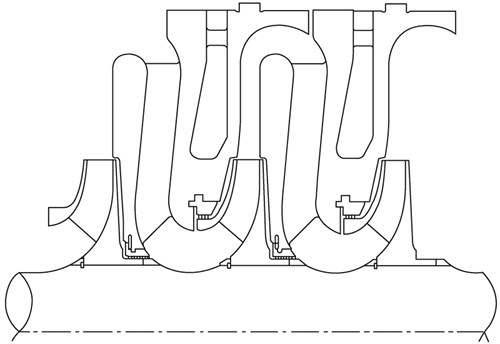 |
|
Fig. 1. Seals are required at the impeller eye and rotor shaft to prevent gas backflow from the discharge to the inlet end of a compressor stage. |
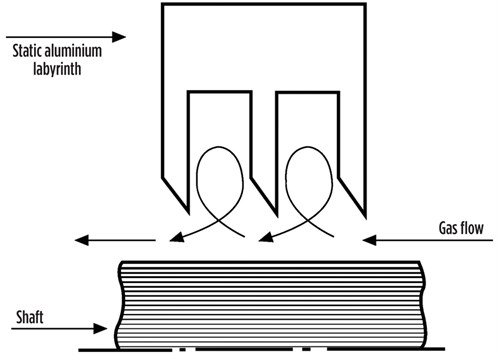 |
| Fig. 2. A new, clean, aluminum labyrinth seal. The seal’s tight clearance and turbulence create resistance to leakage flow. |
Calculations and field performance have demonstrated that wiped interstage seals can decrease unit efficiency by 7% or more. Operating modes that contribute to labyrinth damage include surging, passing through the critical speed and liquid ingestion.
Typically, labyrinth seals have been manufactured from soft aluminum so that, in the event of a rub, the seal will deform and not cause excessive rotor vibration. A hard rub can cause rotor whirl, and the rotor can self-destruct from rubbing on a material that will not deform. For example, in a case where excessive corrosion destroyed aluminum seals, a user made labyrinth seals from cast iron. However, during operation, the rotor touched the labyrinths and initiated a rotor whirl condition so severe that the bearing housings dropped off the compressor body.
A labyrinth seal works by acting as a series of restrictions, like a series of orifices. Turbulence between the teeth causes resistance, in addition to the restriction itself (Fig. 3). Following a rub, the tips of the aluminum labyrinths are mushroomed and limit the turbulence between the teeth. Leakage is then increased due to the higher leakage rate and the reduced turbulence between the teeth.
 |
| Fig. 3. Aluminum seals after a rub. The tips of the teeth mushroom, minimizing the turbulence between the teeth. This mushrooming, along with the increased clearance, makes for a much larger flow through the seal and much lower efficiency for the compressor. |
The size of the restriction (radial clearance) is directly related to the amount of leakage through the seal. Increasing the clearance of the seal will increase the flow, thereby reducing the efficiency of the compressor.
Rub-tolerant seals (Fig. 4) are thermoplastic seals designed to flex when touched by the rotor; therefore, reduced clearances are possible. Polyether ether ketone (PEEK) and Torlon are the most common rub-tolerant seals and have been used for more than 30 yr, but they are less common in new machinery due to their expense and difficulty of machining. However, these seals are excellent for replacement parts, as they can be designed to fit the existing cavity with no other changes required.
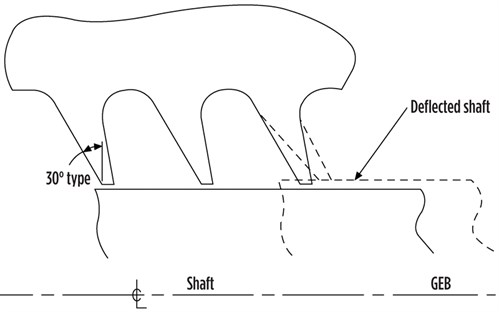 |
| Fig. 4. Rub-tolerant seal made from PEEK. |
For a brief rub, the PEEK material will act as a bearing and deflect. For a sustained rub, the PEEK material will locally overheat, soften and deform—or even melt, opening the clearances to an amount that can be sustained. PEEK is not a good conductor of heat; therefore, the heat generated by a rub is local and does not affect the bulk of the material. For these reasons, the rub-tolerant seals are superior to aluminum seals and can be assembled with very tight clearances.
It is important that the PEEK seal is well-supported (especially in the radial position) by the stationary metal component so that the seal can take friction from the rotating element and “wear in,” as necessary.
A simple test can be conducted, using a piece of scrap PEEK labyrinth seal. Briefly hold the tip of the teeth against a rotating element (smooth drill shank, smooth object in a lathe, etc.) and observe the behavior of the material at the tooth tips.
Today, OEMs typically use abradable seals (Fig. 5) to obtain tight operating clearances and improved efficiency. Compressor efficiency is directly dependent on the impeller eye clearance, Cl. As such, every bit of reduction in clearance helps. However, it is not advised to go too tight with aluminum seals since they might rub and mushroom, thereby eliminating the effect of the reduced clearances.
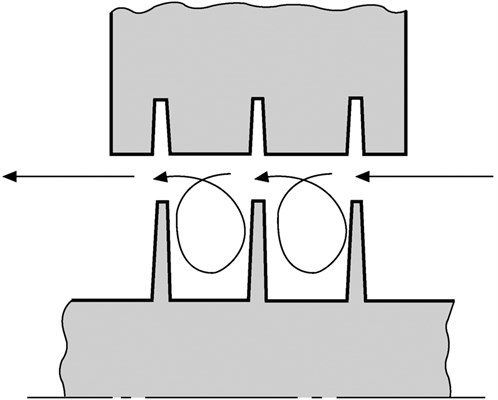 |
| Fig. 5. An abradable seal. Note that the labyrinth teeth are on the rotating member, and the abradable material is the stationary piece. |
Fig. 6 shows the effect of efficiency vs. clearance for various designs. In graph (a), an open centrifugal impeller, the efficiency loss is only one third of a point for each percent of tip clearance ratio at the impeller outer diameter. In graph (b), an axial compressor blade, the efficiency loss is about two percentage points for each percent of tip clearance ratio. This is also true for the throat region of an open centrifugal impeller. In graph (c), for a closed centrifugal impeller, the efficiency loss is about one percentage point for each percent increase in Qi (as a result of QL increasing and constant inlet flow to the compressor).
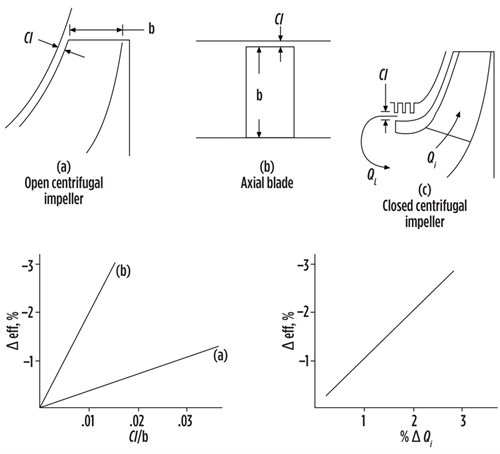 |
| Fig. 6. Effect of efficiency vs. clearance for various designs. |
With PEEK seals, clearances can be reduced to a bare minimum. The limiting factor is the ability to assemble the machine and maintain concentricity. A few mils above the bearing clearances are usually sufficient. GP
Literature cited
- Gresh, M. T., Compressor Performance: Aerodynamics for the User, 3rd Ed., Newnes Books, Elsevier, 2018.
 |
M. Theodore Gresh is President of Flexware Inc. in Grapeville, Pennsylvania. He has been involved for more than 45 yr in the design of high-efficiency centrifugal compressor staging; field testing of compressors, gas turbines and steam turbines; and troubleshooting various field problems including performance problems, rotor dynamic issues, impeller failures and seal problems. Mr. Gresh is the author of Compressor Performance: Aerodynamics for the User, a reference book for compressor design and maintenance trusted by rotating equipment engineers worldwide for more than 25 yr.




Comments